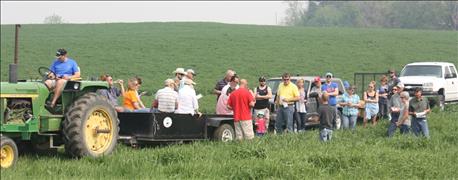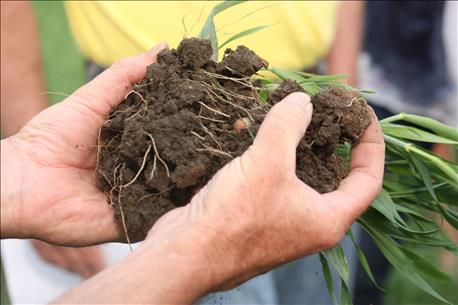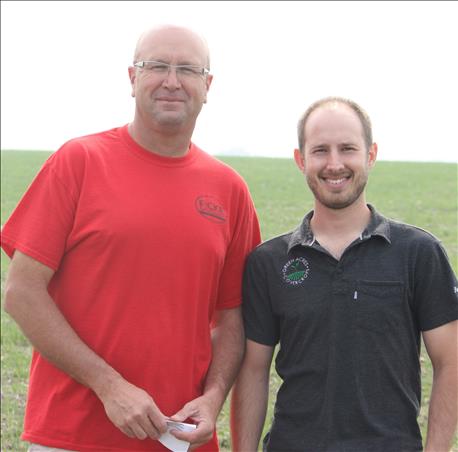
Even after a five-inch rain, one of Del Ficke's cover crop fields could still absorb eight inches of water per hour. It took ten years of a continuous cover crop rotation and cattle grazing to get there, but this particular field also saw an increase in soil organic matter from 2.6% to 6.9% in that time. "There are a lot of things that contribute to why that field is the way it is," Ficke says. "It's ten years of continuous covers, cool and warm season planting, and a huge animal impact. The animal impact of manure and urine is probably what did the most good for that field."

FIELD DAY: Farmers, researchers, and soil health enthusiasts gathered at Del Ficke's farm west of Lincoln in May for a "neighbors helping neighbors" day. The farm has been turned into a research site for Ficke to partner with Nate Belcher of Green Acres Cover Crops to test different cocktail mixes and the benefits they bring to the soil and the wallet, while demonstrating these benefits during field days like these. Photos by Kerry Hoffschneider
This field drew a lot of attention during a "neighbors helping neighbors" day in May at Ficke's farm west of Lincoln. The farm has been turned into a research site for Ficke to partner with Nate Belcher of Green Acres Cover Crops to test different cocktail mixes and the benefits they bring to the soil and the wallet, while demonstrating these benefits during field days like these.
On Ficke's farm, this includes different grazing mixes like barley, turnips, radish, grazing alfalfa, and Sainfoin – a perennial legume similar to alfalfa – as well as fall-seeded mixes that include cereal rye, and legumes like hairy vetch, sweet clover, and red clover.
Research on the farm includes soil tests, infiltration tests, and plant sap analyses to quantify the nutrients being taken up by plants. One of the key questions the farm aims to answer is how the following cash crop responds to specific cover crop mixes.

COVERS AND CATTLE: When it comes to soil health, cattle and cover crops go hand-in-hand. One particular cover crop field on Del Ficke's farm saw an increase in soil organic matter from 2.6% to 6.9% over ten years. Ficke says it took a combination of ten years of continuous cover crops, along with animal traffic and redistributing nutrients in the form of manure and urine to get there.
"Everything we do as far as inputs, fertility, fungicides, herbicides, all those things, we are just minimizing any loss from stresses that that cash crop will endure," says Belcher. "We are trying to set up a healthy soil environment to minimize the stress on those particular cash crops, so when you plant the corn seed in the ground, it already has a good foundation to reach its yield potential."
While yield is a big driver in profitability, efficiency plays a big role as well, and Belcher notes it takes profits as well as efficiency and yield to be sustainable. "I think it's important to have those aspects together. Let's think more than just how many bushels per acre I'm getting – think about getting efficient and maximizing net profit per acre," he says. "Farmers are running a business. You've got to make money."
~~~PAGE_BREAK_HERE~~~
A big factor in achieving these benefits is figuring out how to make cover crops work on your farm. Belcher notes getting cover crops established at the right time takes a systems approach which involves thinking about the entire cropping rotation – using shorter-season corn hybrids, interseeding before harvest, or seeding right at harvest.

Del Ficke (left) and Nate Belcher
Ficke and Belcher have been taking it to the next level by establishing covers as early as right at the time of planting corn, and in some cases, around V4 to V6. "They germinate, and once that canopy closes, they just kind of shut off. Once you harvest, you get quick growth because they're already germinated and ready to capture sunlight," Belcher says. "You can't do that with every cover crop, some will compete with corn. But we're going to try to narrow in on what really works well at the early seeded stage."
And seeding cover crops doesn't have to be expensive, says Ficke. In addition to using a no-till drill, he recently started seeding cover crops using a $400 broadcast seeder mounted on the front of a UTV.
"If you're just running cattle and not doing row crops, you can run almost all your operation on that one piece of equipment. $12,000 for a UTV is significantly less than a new tractor and drill, and we're using it for something every day of the year," Ficke says. "There are a lot of times we'll just broadcast the seed and let the cows tromp it in. We're replacing a lot of machinery with cows in a high density scenario."
Getting the most out of cover crops also takes a systems approach. Much of the organic matter increase on Ficke's five-acre field came from redistributing nutrients in the form of animal manure, and by continuous cover cropping and letting those covers grow to full maturity. "One entity writes a check to another in this case," he says. "That field calls for absolutely zero inputs. We know we can replicate that across every acre if we continue to do what we're doing there."
About the Author(s)
You May Also Like






